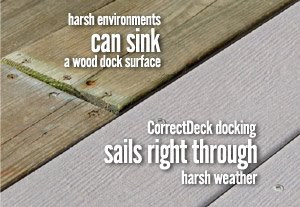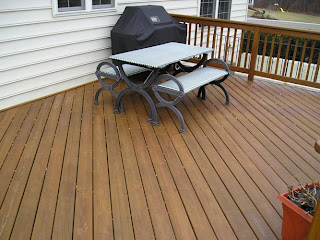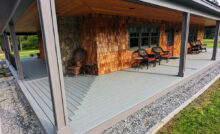Diagonal Decking Layout


As you can see in the photos the butt joint can become a really bad maintenance issue. The reason there is significant waste is you t

A much better method is to install all of the decking on an angle. The key here is to set the angle so that you only cut a small piece off of both ends to create the angle. By doing this you can use a full 16 foot long piece each time until you get to the end of the deck. I would estimate that you’ll save 10% compared to using a standard perpendicular decking layout.

The other great benefit is you completely eliminate the butt joints. All of the decking boards will span from the front of the deck to the back of the deck. Next time you plan on installing decking on a deck take the time to consider this installation. Not only will it save you money, it will be easier to maintain and it has a much richer aesthetic appeal.
Recent Posts
Framing Stick Nailer vs Coil Nailer
Which is Better a Stick Nailer or Coil Nailer? Framers have many choices in nailers…
How Many Roofing Nails Per Square of Shingles
Estimating How Many Nails for a New Roof When it comes to estimating materials for…
Composite / PVC Decking – Layout Tips & Advice
Composite / PVC Decking Layout Tips and Advice Composite and PVC decking have really changed…
Benefits of an ERV System (Energy Recovery Ventilator)
Benefits of ERV Systems (Energy Recovery Ventilator) If you're building a new home or doing…
Vermiculite Attic Insulation Abatement
Vermiculite Attic Insulation If your home was built before 1990 there is a chance it…
Nuisance Tripping of AFCI (Arc Fault) Circuit Breakers
Arc Fault (AFCI) Circuit Breakers Tripping Often An arc-fault circuit interrupter (AFCI) or arc-fault detection…


View Comments
Not to mention that the diagonals look way better too. Our deck is installed with diagonal boards, no joints whatsoever. We love it.
I would only add that the angle you lay has to atleast put the board over several joists, so you probably don't want to go much less than 45 degrees.
Correct my if I'm wrong.... diagonal decks are also "stronger" since the long boards can span more joists.
That might be a bit of a stretch from a structural engineers point of view. You could probably argue that it is stronger "in plane" so that it prevents any racking of the deck surface. The real bonus here is the elimination of the but joints that warp and look awful.
That's a great idea. I had no idea diagonal decks were stronger. I just thought they were different design. I'll suggest that the next time. And I'll have a better reason when I'm asked why.
Right on time. I was about to research about replacing my 50 yr ols deck.
As a deck contractor, I love installing decking in a herringbone setting. And yes, it does most certainly strengthen your deck.
If I install a herringbone pattern though, isn't that just the same as having a series of butt joints down the middle of the deck. Doesn't this pattern suffer from the same issue of warping joints?
Yep ! - the the only way to curb that problem is to install decking bark side up and instead of butting together - raise joist at meeting point - which serves as a separation as well as a definition border
It doesn't save money because your joists usually need to be placed closer together to compensate for the longer span (1.4x) that the decking has to cover. You will also spend more time installing the decking.
We moved to a house that has a diagonal-style layout, however there are some joints throughout. It's a second story deck, and we're not sure if it was added on to at a later time than the original part, but it appears to have been treated to look like a TREX composite. I'm just a sister-in-law writing this and have no experience in construction, etc., but some of the joints have a little cracking around the "jolt head" nails? That's what I think they may be called, I've not been told that by anyone, but have looked online for the type of nail. Anyway, there is a little cracking or splintering around the nail towards the edge or end of the board at the joint. What is causing that and how long will it be until it is a big problem?
The material split due to how close the nail is to the end of the board. If the deck has been there quite awhile it's likely not going to get any worse.